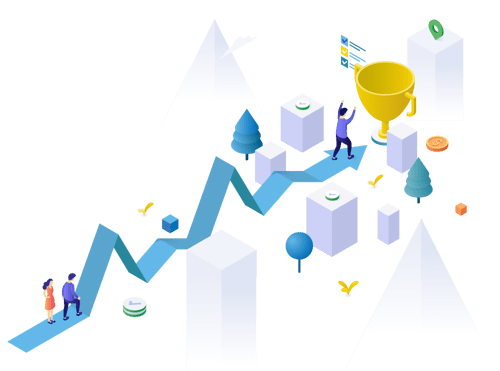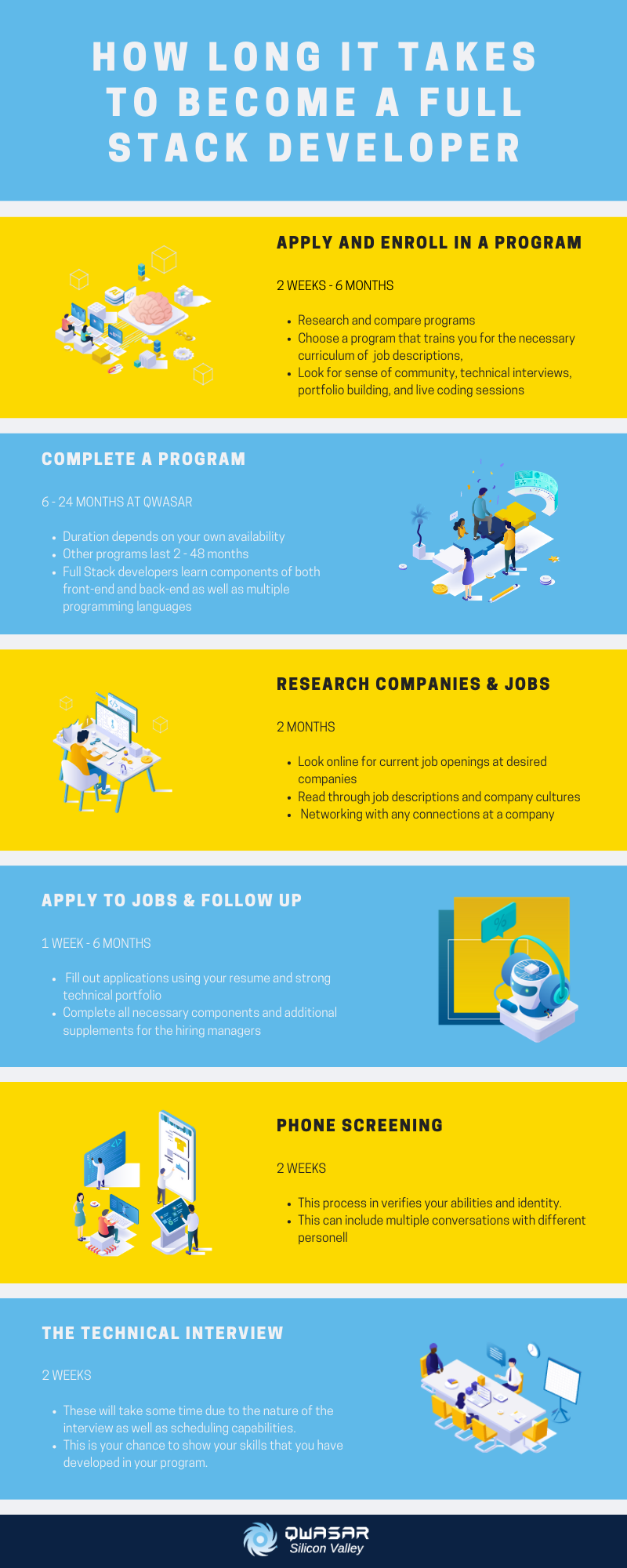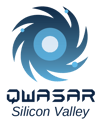Identify your goals/intentions
Once you make the choice to become a full stack developer, there are a few things you need to identify prior to your journey. It is crucial to understand your motives and intentions. Is there a specific role or company you aspire to work for? Is there a career path you have been wanting to go down? Are you a CS grad and don’t know where to go next? There are high-quality, low cost programs out there to make you an elite candidate in a competitive full stack development job market.

Whatever background you come from - CS graduates, bootcamp graduates, self-taught, graduate students, or front-end developers - there are many different paths and programs to becoming a full-stack engineer. Part of the challenge today is to find a path that will work for you, for the job you want to get, and for your budget.
How Long Does it Take
Becoming a full stack developer is a process that will take some time, but not as much as you may think. Most programs take on average 9 - 18 months to complete. This estimate can vary based on a number of factors. Some of these factors include:
- Your own personal availability to learn
- How long you spend practicing
- How long the job search process takes
Learning on your own using resources on the internet vs being in a structured program with accountability and a learning path are two very important factors as to how long your program can take, as well as what you get out of it. Some of these factors are out of your control and should not discourage you from pursuing this path. If you truly want to become a full-stack developer, there are part-time and full-time programs which you can dedicate yourself to. The search for a job can take at a minimum 5 weeks depending on the company and length of application process.

Front-end vs. Back-end
Full stack developers engage in a curriculum that exposes them to both the frontend and backend of websites/applications. The frontend of a website includes what the users and everyday people will view when they visit that specific website and interact with its features. This is where websites have nice visual appearances and all the design components/elements display correctly. The frontend of a website uses programming languages like JavaScript, CSS, and HTML. The backend of a website is the infrastructure and coded part that users don’t directly interact with. Some of the programming languages used for backend are PHP, Python, and Ruby. Backend is used for larger volume website development and work with front-end developers to ensure the code is working properly.
Full stack development is a myriad of both the frontend and backend. They are able to utilize both sides of the website development with their own individual skills and strengths. This makes them more marketable and better capable of attaining jobs in today’s world. At this point, developers need some sort of understanding of both frontend and backend to be successful. Our programs range from 7 - 12 months to complete for a Full Stack Developer track. This is dependent on a lot of factors as listed above.
Necessary Curriculum-Find a course that teaches you these
Some of the programming languages and topics that you will need to be proficient in:
- Javascript
- IDE
- Terminal
- Ruby
- Python
- C
- HTML
- CSS
- Data structures and algorithms, i.e. strong SWE fundamentals
- Concept of architecture
You will need to find a program that includes these languages in their curriculum. Specifically, you want to make sure you are familiar with them and able to complete projects directly using these languages and topics. Finding a course can be challenging, but you can use resources like CourseReport, CareerKarma, and SwitchUp to hear real student reviews.
Don’t forget to look at the entire program outside of the curriculum. Ask yourself questions like:
- Is there a sense of community?
- Are they preparing me for technical interviews?
- Will I be doing live coding sessions?
It’s essential that you find a program that enables you to build confidence in how you code and in your decision-making ability. The soft skills and personal development skills are just as important as the technical skills in coding. Being able to understand multiple programming languages is key to landing that dream job.
Be confident
Confidence will get you very far both in our programs and in life. It is important to always remember that there is a goal at the end. Remembering why you started is important to deciding not to give up. There will be challenges and there will be roadblocks in your way to completion, but that is normal. You won’t be alone in your journey, as other students and mentors will be available to bounce ideas and concerns off. Choosing a program that has a great sense of community will ensure you have the skills to succeed. You will be able to ask questions and be mentored on topics you may not understand.
Be prepared for Jobs
The process of applying to a job can be daunting - some even say it's a full time job just to apply to jobs. Some of the job titles you may look at include: Junior Full Stack Developer, Full Stack Developer, Full Stack Engineer, Software Development Engineer, API Engineer. However, the more prepared you are, the easier it will be. Before going into the application process, make sure you have completed and feel confident in technical interviews, have a strong technical portfolio, an updated and revised resume, and a well-rounded education of all the necessary components of the job descriptions. Technical interviews take practice, it’s not about doing coding exercises on your own, it’s about communication skills and problem solving skills. A strong technical portfolio is not developed overnight, this takes time to build efficiently and have it reviewed. This can take a minimum of 2 months to dive into the research component of industries and job boards, plus physically completing the applications. Another important task is to network and talk to mentors in the field. This can be done through LinkedIn, MeetUp, EventBrite or other connections you have gained in your technical interviews and coding journey. Working on and developing your networking skills can include practicing elevator pitches, building a personal brand, and giving your all. This is the part that truly gets you the position over another candidate. It is always a great idea to follow up any phone conversation or interview and thank them for their time. This step is both respectful and compassionate.
Once you have selected a position to apply for, the timeline for getting a job will be at a minimum 5 weeks:
1 week = Application to be received
2 weeks = Phone screening
2 weeks = Technical interviews

Other Alternatives
If you decide full stack is not the right path for you, there are many other elite programs you can join. Whether it's software engineering, data science, AI/Machine Learning, DevOps/Cloud Engineering, etc. These paths involve different curricula and can open job opportunities you may not have previously considered. Like mentioned before, failure is not final and giving up is not an option.
Ask yourself why? If there's a certain aspect of full-stack that you do not enjoy, there are other paths that may suit you better. If you do not enjoy math, a track in AI/Machine Learning may suit you better. If the design component of full-stack is difficult for you, an adjacent career as a UX designer may work out better. It is all about finding what suits you best and where you will best be able to succeed and achieve your goals.


